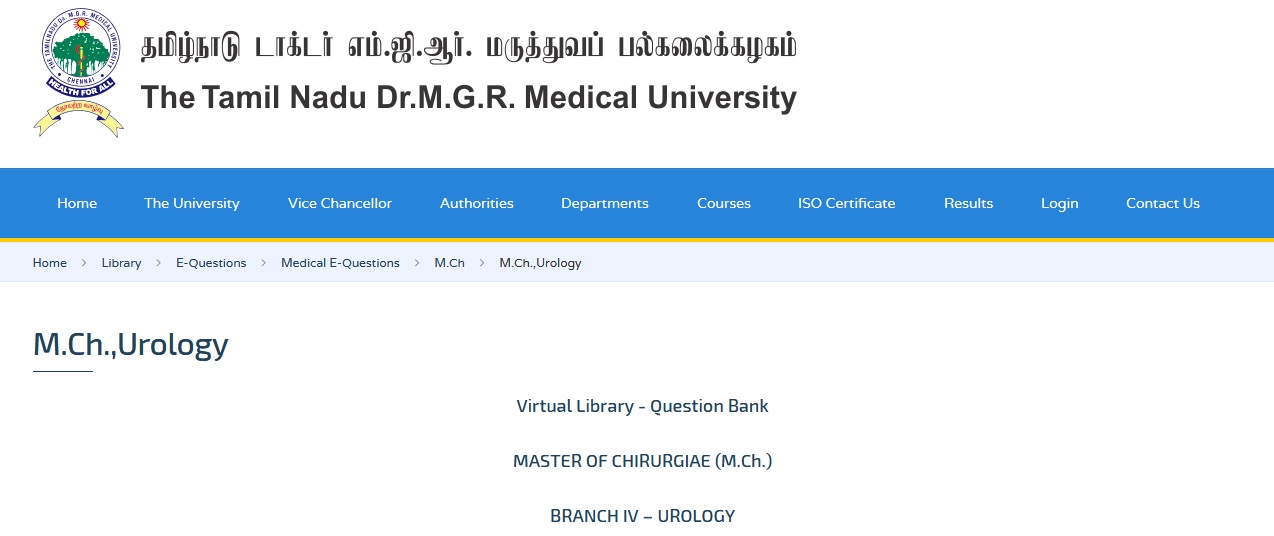General Adult & Paediatric Urology M.Ch Question Bank : web.tnmgrmu.ac.in
Name of the University : The Tamilnadu Dr. M.G.R. Medical University
Degree : MASTER OF CHIRURGIAE (M.Ch.)
Branch : Branch IV – Urology
Subject Code/Name : 1652/General Adult & Paediatric Urology
Paper : II
Document Type : Question Bank
Website : web.tnmgrmu.ac.in
Download Model/Sample Question Paper :
2007-2014 : https://www.pdfquestion.in/uploads/web.tnmgrmu.ac.in/4568-181652KU.pdf
TNMGRMU General Adult & Pediatric Urology Question Paper
Sub. Code: 1652
M.CH DEGREE EXAMINATIONS
(Higher Specialities)
(Revised Regulations)
Branch IV – Urology
Paper II :
Q.P. Code: 181652
Time: Three hours
Maximum: 100 Marks
Related : TNMGRMU Regional Systemic Urology M.Ch Question Bank : www.pdfquestion.in/4570.html
August 2009
ANSWER ALL QUESTIONS :
Draw suitable diagrams wherever necessary. :
I. Essays: 2 x 20 = 40 Marks
1. Discuss the management of urolithiasis with chronic renal failure.
2. Discuss the etiology of hypospadias. How do you evaluate a child with proximal hypospadias.

II. Write short notes on: 10 X 6 = 60 Marks
1. Mechanisms of renal failure in dominant polycystic kidney disease.
2. Crede’s maneuver.
3. Squamous cell carcinoma of the urinary bladder.
4. Enumerate the indications for immediate repair of bladder injury.
5. Enumerate the differentiating features between congenital and acquired bladder diverticulum.
6. Neobladder rupture.
7. Valve bladder syndrome.
8. Giggle incontinence.
9. The dislocated testis.
10. Sacral agenesis.
August 2010
Sub. Code: 1652
I. Essays: 2 x 20 = 40 Marks
1. Discuss the various options in the management of recurrent urinary tract infection due to re-infection in a 30 year old lady.
2. Discuss the aetiopathogenesis and management of chyluria.
II. Write short notes on: 10 X 6 = 60 Marks
1. Renal osteodystrophy.
2. Spontaneous renal haemorrhage.
3. Female varicocele.
4. Mega calicosis.
5. Leak point pressures.
6. Bilateral single system ectopic ureters.
7. Megalourethra.
8. Sibling reflux.
9. Genital defects in extrophy-epispadias complex.
10. Sertoli cell only syndrome.
August 2011
I. Elaborate on :
1. Describe the development of Trigone and Urinary Bladder. How will you evaluate and manage a 5 year old Child with Vesico – Ureteric Reflux.
2. Discuss the Aetiopathogenesis, Clinical feature and management of Chyluria.
II. Write notes on :
1. Mechanism of Renal failure in Dominant Polycystic Kidney.
2. Etiology and management of Squamous cell Carcinoma of Urinary Bladder.
3. Megalourethra.
4. Bilateral Single System Ectopic Ureter – Clinical feature and management.
5. Serotoli cell only Syndrome.
6. Prune – Belly Syndrome.
7. Yolk Sac Tumor – Testis.
8. Carcinoma in Situ Bladder – Clinical Feature and management.
9. How will you manage Post Renal Transplantation Oligo – Anuria.
10. Penile Fracture.
August 2012
I. Elaborate on :
1. Etiopathogenesis of bladder exstrophy and describe the steps of primary exstrophy repair.
2. Natural history of benign prostatic hyperplasia and the principles of its medical management.
II. Write notes on :
1. Neourethral coverage in hypospadias repair.
2. Management of post-transplant ureteric stricture.
3. Organ sparing treatment of penile carcinoma.
4. Urine analysis – diagnostic implications.
5. Detrusor external sphincter dyssynergia.
6. Evaluation of the recurrent stone former.
7. Urological applications of botulinum toxin.
8. Jejunal conduit syndrome.
9. Intensity modulated radiation therapy – application in urology.
10. BCG failure – management.
August 2013
I. Elaborate on: (2X15=30)
1. Describe the risk stratification and management of good risk metastatic nonseminomatous germ cell tumors of the testis.
2. Discuss the pathophysiology and management of vesicoureteric reflux.
II. Write notes on: (10X7=70)
1. Algorithm for diagnosis and management of ejaculatory duct obstruction.
2. Pathophysiology of interstitial cystitis.
3. No scalpel vasectomy.
4. Management options in failed pyeloplasty.
5. Prognostic factors in renal cell carcinoma.
6. Abdominal leak point pressure.
7. How to evaluate the function of a non-visualized kidney on intravenous Urogram.
8. Valve bladder syndrome.
9. Growing teratoma syndrome.
10. Tests for biochemical diagnosis of Pheochromocytoma.
August 2014
Sub. Code: 1652
Answer ALL questions in the same order.
I. Elaborate on: (2 x 15 = 30)
1. Discuss the Antenatal diagnosis of Hydronephrosis and the post natal management of antenatally diagnosed hydronephrosis.
2. Discuss the pathogenesis, investigations and treatment of castrate resistant prostate cancer.
II. Write notes on: (10 x 7 = 70)
1. Urinary diversions in Posterior Urethral Valves
2. Hyper filtration renal injury
3. Injection therapy in VUR
4. Desmopressin
5. Captopril Renography
6. Oncogenes
7. Von-Hippel Lindau syndrome
8. Diagnosis and management of priapism
9. Contrast nephropathy
10. Post obstructive dieresis.
August 2015
Sub. Code: 1652
Answer ALL questions
I. Elaborate on: (2 x 15 = 30)
1. Discuss developmental anomalies of kidneys with management options of their complications.
2. Discuss pathophysiology, manifestations and management of genito urinary tuberculosis in an adult male.
II. Write notes on : (10 x 7 = 70)
1. Testicular torsion.
2. Verrucous carcinoma of penis.
3. BCG failure in the management of carcinoma bladder.
4. Medical management of erectile dysfunction.
5. Hyperoxalosis.
6. Hyperfiltration renal injury.
7. Detrusor – sphincter dyssynergia.
8. Desmopressin.
9. Snodgrass repair for Hypospadias.
10. Injection therapy in VUR.
August 2016
I. Elaborate on : (2 x 15 = 30)
1. The genetics, pathology and management of Wilms tumour.
2. The management of spontaneous prostate related bleeding.
II. Write notes on: (10 x 7 = 70)
1. Management of (Vesicoureteral Reflux) VUR in children.
2. Female urethral diverticulum.
3. Circumcision and complications of circumcision.
4. Marginal kidney donor.
5. Ongogenes.
6. Optimizing the outcome of Extracorporeal shock wave lithotripsy (ESWL).
7. Clean Intermittent Catheterization.
8. Chemoprevention of prostate cancer.
9. Calyceal diverticulum.
10. Multicystic dysplastic kidney.